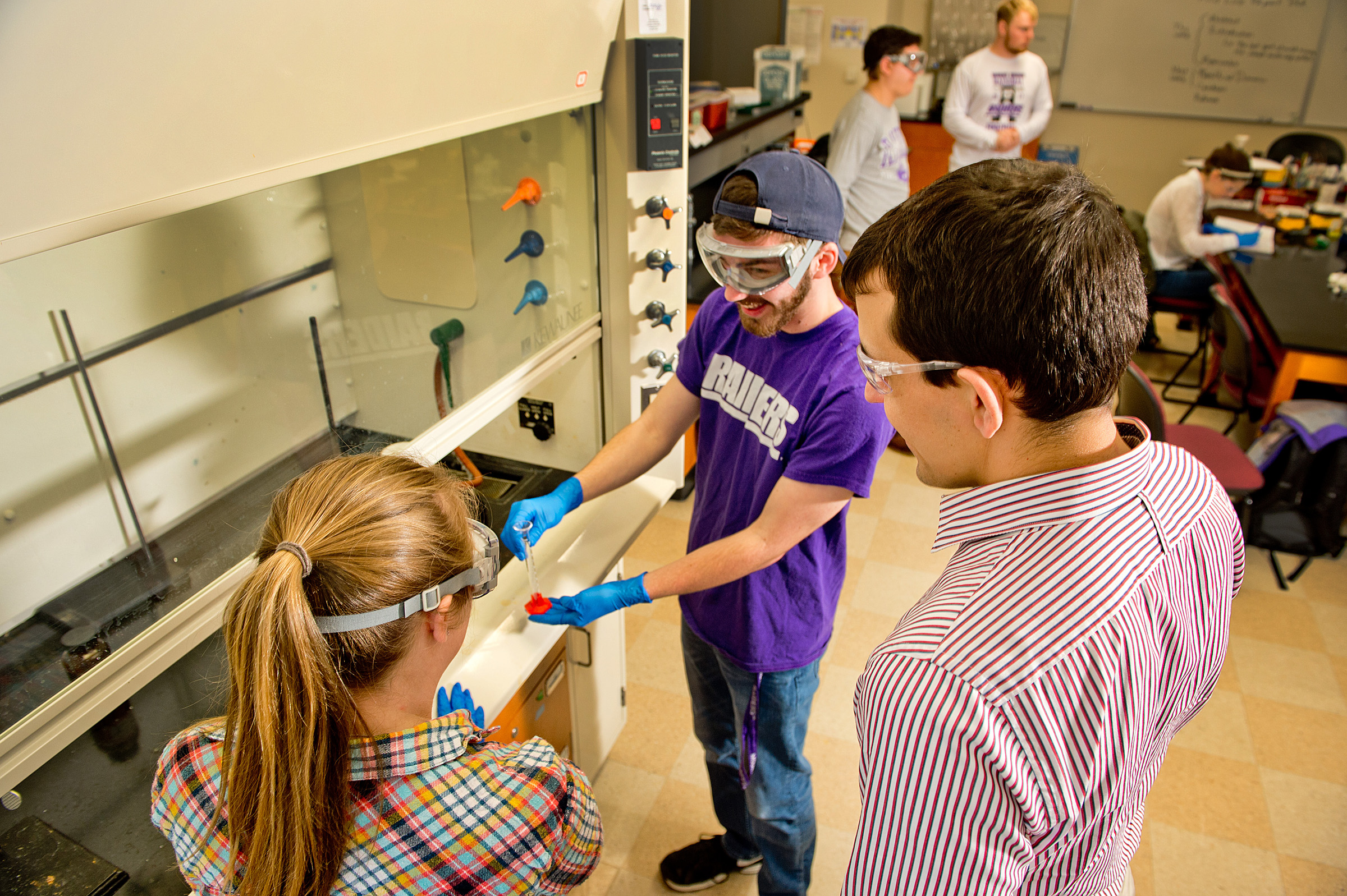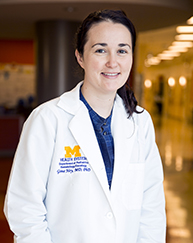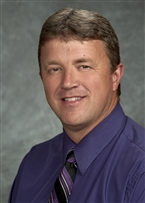Bachelor of Science in Chemistry Degree
Establish technical competence and nurture deep interests in the Bachelor of Science (BS) in Chemistry degree program at the University of Mount Union. Here, you’ll put everything you learn into practice, both in our state-of-the-art on-campus labs and in professional internship environments.
Our BS in Chemistry program is accredited by the American Chemical Society (ACS), and our graduates embrace early-career success in professional roles and highly-ranked graduate programs.
Extensive Practical Training
At Mount Union, you will deepen your understanding through laboratories and seminars, design one-of-a-kind research projects, and become fluent in using modern scientific instruments and electronic resources.
Our BS in Chemistry program is built upon principles and recommendations of the American Chemical Society. You’ll develop a broad foundation in biochemistry and analytical, organic, and inorganic chemistry, then hone your focus in the elective areas that provoke your passion. This layered, customizable approach provides you with a strong base from which to launch your professional career or pursue graduate studies.
Access to Cutting-Edge Facilities
Pursuing a chemistry degree at Mount Union grants you access to state-of-the-art sampling, measuring, and analysis technologies. You’ll learn to use and apply high-tech equipment for independent research projects and faculty-student collaborations alike. The tools you use here, including plate readers, chromatographs, and spectrometers, are mainstays of real-world chemistry professions—in other words, you’ll be well prepared for professional success.
-
ACS
Accredited
-
57
Credit Hours of Discipline-Specific Coursework
-
2
Student Organizations for Chemistry Majors
-
7
Leading-Edge Chemistry Analysis Tools
Learn More About the Chemistry Major
Learn by doing in the Bachelor of Science in Chemistry program at Mount Union. Our technologies and facilities—along with opportunities to research, teach, and intern—equip you with robust skills and competencies that will impress future employers and graduate programs.
Request information to further explore the ACS-accredited bachelor’s in chemistry program, or apply now to get started.
-
Curriculum
Chemistry CurriculumAs a chemistry major, study inorganic, organic, analytical, and physical chemistry in great depth. In your elective choices, you’ll expand your knowledge in specialty areas like forensic chemistry, advanced spectral analysis, applied thermodynamics and kinetics, and neurochemistry.
Dive into vital research through hands-on laboratory courses, including wet chemical and instrumental analysis techniques, and use our extensive high-tech spectrometry and chromatography equipment. You’ll also gain experiential practice through individual research, student organizations, and internship opportunities.
-
Experiential Learning and Student Organizations
Chemistry Experiential LearningReal-world experience is essential to the bachelor’s in chemistry curriculum at Mount Union. These extracurricular and work-based opportunities help strengthen your skills and knowledge in chemistry, meaning you’ll strengthen your position as an applicant for professional roles and graduate programs.
Seize hands-on practice through:
- Independent undergraduate research
- Research with faculty or student peers
- Summer research projects with Mount Union faculty members through the Pappenhagen Research Award
- Research Experience for Undergraduates (REU), a competitive research program sponsored by the National Science Foundation
- Laboratory experience
- Membership in chemistry student organizations
- Internships
- Working our summer science camp
- Teaching chemistry to Alliance-area youth
Student Organizations
Student organizations can ignite your passions and expand your ideas of what teamwork, networking, and leadership can look like during your chemistry degree. These opportunities contribute to the holistic learning experience at Mount Union, where we value every chance to teach and grow.
Join your peers in:
- American Chemical Society
- Alembroic Society (chemistry honor society)
Internships
Graduate with two impressive lines on your resume: a BS in Chemistry and an internship. By taking on an elective or extracurricular internship, you’ll demonstrate to employers and graduate school admissions teams that you are passionate, experienced, and willing to take risks to achieve your goals.
Mount Union’s robust classroom and lab-based learning equips you to excel in internship roles with employers like:
- State of Ohio Crime Lab
- Firestone
- Sherwin-Williams
Teaching Chemistry To Alliance Youth
As a first-year student in Dr. Sheryl Mason’s Organic and Biochemistry for Nursing class, you’ll teach high-level scientific principles to elementary students! These engaging experiments include “Crush the Can,” “Growling Gummy Bear,” and “Glow-germ Lotion.” Do you remember any complex chemistry lessons from your elementary school days?
-
Careers
Chemistry Careers“Chemists … transform the everyday materials around us into amazing things.” — the American Chemical Society (ACS)
Every day, chemists are conducting experiments in search of cancer treatments and cures, monitoring the ozone that protects us from the sun, discovering new materials to make our homes warmer in the winter, and reimagining textiles for our clothes and homes. With a BS in Chemistry, you will open the door to a rewarding and impactful career.
Here at Mount Union, you can tailor your chemistry major courses to your interests and career aspirations. The path you choose—likely with the help of a trusted faculty mentor— positions you for long-term success in your career and your passions.
Recent Employers- McGean-Rohco
- Amgen
- The Scripps Research Institute
- Steptoe and Johnson
- Sherwin-Williams
- Premix
- Jackson Local School District
- United Seal
- Nanotechnology, Inc.
Common Careers- Environmental Analysis
- Material Science
- Pharmaceuticals
- Biotechnology
- Medicine
- Allied Health
- Education
Recent Graduate Schools
- Carnegie Mellon University
- Massachusetts Institute of Technology (MIT)
- University of North Carolina-Chapel Hill
- Penn State University
- University of Kansas
- University of Indiana
- Case Western Reserve University
-
Facilities and Equipment
Facilities and Equipment
Here in the Bracy Hall of Science, you’ll access leading edge instrumentation, computer resources, library books, and journals. These high-quality tools are hard to find in other programs of our size, and they facilitate rewarding academic experiences—both in the classroom and in your independent research.
Chemists utilize many high-tech instruments to determine the properties of molecules. Listed below are the major instruments you may use as you work toward your BS in Chemistry.
Fourier Transform Infrared Spectrometer (FT-IR)
Different types of molecular bonds absorb infrared light differently. We can measure this absorption with a Fourier Transform Infrared Spectrometer (FT-IR) and identify which types of bonds (and therefore which functional groups) are present in a sample. This helps us determine some of the chemical features of a given molecule.
Plate Readers
Chemistry majors use plate readers to measure the absorbance or fluorescence of many very small samples in a short period of time. We often use these instruments in biochemical studies such as determining the concentration of protein in a sample, monitoring enzymatic reactions, and studying protein-DNA binding.
Gas Chromatograph (GC)
A Gas Chromatograph (GC) vaporizes a sample and moves it through a column of tubing. The rate of migration of a given molecule through the column depends on its attraction to the column material. This causes the components of a sample to separate. As the components exit the column, their relative amounts are detected. The technique can be used to determine the purity of a sample, how many components are in the sample, and some information about the chemical properties of the components.
Gas Chromatograph-Mass Spectrometer (GC-MS)
A Gas Chromatograph-Mass Spectrometer (GC-MS) takes the GC a step further. After the molecules have been separated by a GC, they are analyzed by mass spectrometry, which precisely determines the molecular mass of the molecules present in the sample. Mass spectrometry may also cause fragmentation of the molecules, which can give further insight into the molecule’s structure. This technique can positively identify the molecules present in a sample, and is often used in forensics, drug analysis, and disease identification.
High-Performance Liquid Chromatography (HPLC)
Similar to the GC, in High-Performance Liquid Chromatography (HPLC), the sample travels through a column, this time as a liquid solution. We use HPLC to analyze the contents of samples such as pharmaceuticals and consumer products, and to monitor enzymatic reactions.
Atomic Absorption Spectrometer (AA)
If an atom becomes excited, it can emit light of specific wavelengths. These wavelengths differ by the identity of the atom. The Atomic Absorption Spectrometer (AA) excites a sample and measures the resulting atomic absorption spectrum. This spectrum acts like a fingerprint, and we can determine if a particular atom is present in the sample.
Ultraviolet-Visible Spectrophotometer (UV-VIS)
A UV-visible spectrophotometer measures the degree to which a sample absorbs light in the ultraviolet and visible regions of the spectrum. This technique can be used to determine the concentration of a molecule in a sample or to give clues to the identity of the compounds present in a sample.
Nuclear Magnetic Resonance Spectrometer (NMR)
Nuclear Magnetic Resonance (NMR) is a powerful technique that applies a strong magnetic field to a sample, causing the spins of the atomic nuclei to align. When radio waves are applied to the sample, some of the nuclei become unaligned (flipped). The frequency of the radio wave required to flip a given nucleus depends on the chemical environment of the atom.
The spectrometer measures how the sample absorbs these radio waves, allowing us to determine a great deal of information about the chemical structure of the sample.









